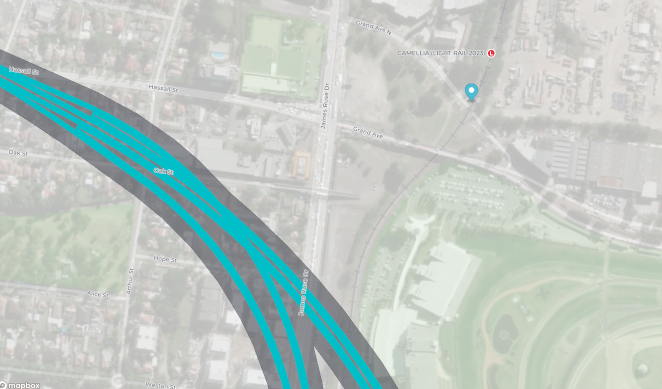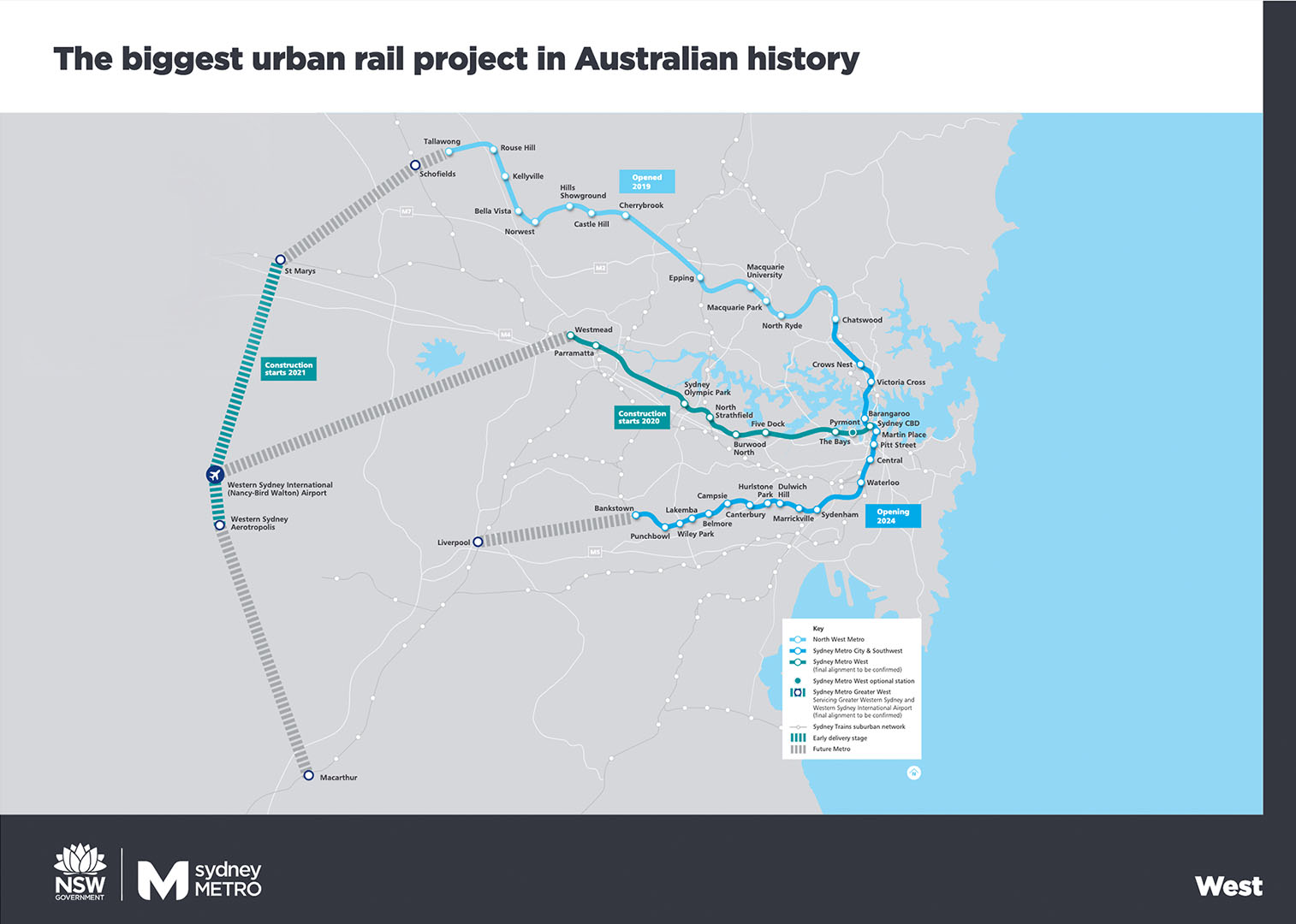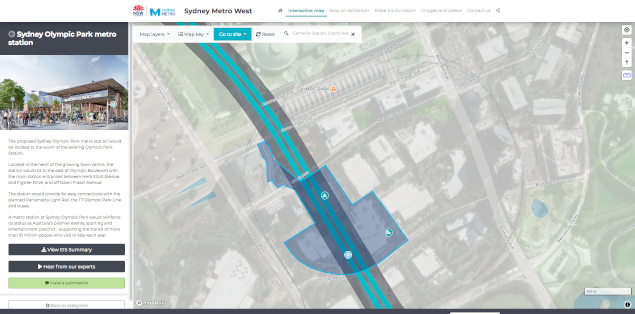

| Action for Public Transport (N.S.W.) Inc. |
| P O Box K606 |
| Haymarket NSW 1240 |
| 26 June 2020 |
Action for Public Transport (NSW) Inc. ("APTNSW") is a transport advocacy group active in Sydney since 1974. We promote the interests of beneficiaries of public transport - passengers and the wider community alike.
KEY POINTS
APTNSW supports the proposal. In more normal pre-COVID times, the capacity of the Sydney Trains Western Line is exceeded in peak hours and the problem is worsening as Sydney's population grows. Metro West will provide relief capacity for this line and it warrants high priority.
The overarching aim should however be to create a network of integrated public transport services across Sydney. The network should be in the form of a grid, or a web, with convenient interchanges between different modes and different routes. Such a grid is shown in Figure 51 in the Future Transport 2056 strategy.
There is room for considerable improvement in the contribution this proposal makes to that outcome. Specifically, interchange arrangements are inferior and the 7km gap between stops at Olympic Park and Parramatta is excessive. In our view these deficiencies can and should be rectified.
INTEGRATION WITH OTHER PARTS OF PUBLIC TRANSPORT SYSTEM
In our view, the West Metro route and station locations should be designed to create a "network effect". To achieve this, there should be convenient interchanges between West Metro, the light rail and heavy rail system, other metro lines, and major bus routes.
Connections with other Metro lines and the existing rail system should be cross-platform wherever possible. A passenger should be able to alight from Metro West and cross the same platform to get onto a connecting service (whether "heavy" rail or Metro Rail, and possibly light rail).
If this approach is taken, the effective coverage and usage of the West Metro will be maximised, as will the coverage and usage of the existing system. The result (the "network effect") will be increased patronage on all lines. The whole will be more than the sum of its parts.
This is not yet the case in the proposal as currently designed. We welcome the fact that there are interchange points between West Metro and Parramatta Rd buses at North Strathfield (T1 line) and Westmead (T5 and T1 Western lines). From our reading of the diagrams, it appears however that more attention needs to be paid to making these interchanges physically easier and more intuitive for passengers.
Specific opportunities to facilitate interchange between routes and modes are set out later in this submission.
DISTANCE BETWEEN STATIONS
To maximise the usefulness and the patronage of Metro West, it should be easy to walk or cycle to metro stations, as it is in Paris and Tokyo. The stations on the Metro West route should consequently not be too far apart.
Typical metro systems around the world only have a few more kilometres of track than they have stations (there is an informative table at http://fixnswtransport.com/sydneymetro/review.html#appendix which was based upon the table at https://en.wikipedia.org/wiki/List_of_metro_systems#List, that is, the average spacing between stations is generally less than 1.5 km and sometimes much less. For example, the Paris metro has 302 stations but only 214 km of track.
The average distance between adjacent stations on the Bankstown line between Sydenham and Punchbowl is approximately 1.3 km.
By contrast, the 7km gap between the proposed stations at Olympic Park and Parramatta is unusual and excessive in an urban context. APTNSW believes that there is a strong case for an additional stop at Pyrmont and possibly one at Camellia. The distance between Metro West and the light rail stop at Camellia is tantalisingly short:

We are aware that there is a countervailing push to minimise stops to keep the trip time between the harbour CBD and the Parramatta CBD short. On balance, though, we submit an additional stop in an area in need of better public transport, and an additional opportunity for interchange, is warranted.
EXTENSION THROUGH HARBOUR CBD
Information is not yet available regarding the Bays to City section of the project, but we take this opportunity to emphasize our preference for a stop in Pyrmont/Ultimo (connecting with the Inner West light rail).
Within the city, we would envisage a stop at Pitt St. metro station providing cross-platform interchange with the North-west/Bankstown metro. It is not too late to redesign Pitt St station to allow platforms to be stacked double-deck.
The line should not terminate in the Sydney CBD; it should continue across the city from the outset (avoiding the need to construct a terminal station in the CBD). There are various options consistent with Future Transport 2056. The line could for example continue east and south to Randwick, splitting there to service Kingsford-Smith Airport and Maroubra Junction as indicated in Future Transport 2056 (Figure 51). This would provide relief to the CBD & S-E light rail. If the line were also to be extended to the new Western Sydney Airport as indicated, there would then be a rail connection between the two airports:

The line could alternatively continue from the Harbour CBD generally along the line of George St and Broadway, to serve trip generators such as Haymarket, Sydney University, RPAH and Parramatta Rd, all of which warrant underground transit services.
WESTMEAD STATION
The EIS proposes that Westmead Metro Station be built underground and to the south of the existing Sydney Trains' surface station, below Alexandra Avenue, with just one entrance, on Hawkesbury Road.
This is less than optimal from the passenger's point of view. Westmead Metro station is (at least initially) a terminal station, implying considerable pedestrian activity. The western terminus of Parramatta Light Rail is very close. So that point will be an interchange between heavy rail, light rail and metro. Walking distances should be minimised and there should be satisfactory weather protection. Long walking distances result in longer overall travel times. This dampens patronage, in this case needlessly.
The Metro station should be relocated north of the Sydney Trains' station, enabling much shorter, safer, and faster pedestrian links to that station, the hospital precinct, the University of Western Sydney campus and the light rail terminal. A direct, "Opal-tag-free" underground pedestrian link should be provided to the Sydney Trains platforms.
A tag-free link to the Sydney Trains platforms should be provided even if the Metro station remains in its currently planned location.

OLYMPIC PARK STATION
No provision has been made for terminating trains at this station. Given the likelihood of "event" crowds, such provision should at least be anticipated. We suggest that provision be made for one or more terminating tracks and double-sided or "Spanish" platforms. Such provision would require a much wider excavation box than is presently proposed for Olympic Park station.

NORTH STRATHFIELD STATION
Given the likelihood of a high volume of interchanging passengers, short, all-weather, tag-free pedestrian links should be provided between the Sydney Trains T1 line and Sydney Metro West.

CONCLUSION
It is encouraging to see that Metro West is progressing, as the T1 Western line is under strain and additional capacity is needed.
Our main concern is that some opportunities to better integrate the Metro line with other modes have been overlooked. We hope to see improved interchange arrangements in the final scheme. We strongly favour an additional station at Pyrmont. We also favour an additional station between Olympic Park and Parramatta at Camellia, linking to the light rail system now under construction.
APTNSW appreciates the opportunity to comment on this proposal, and we look forward to the opening of Sydney Metro West.